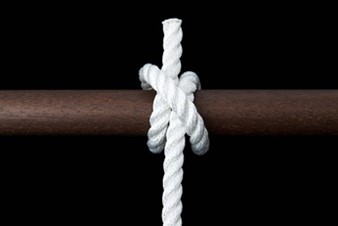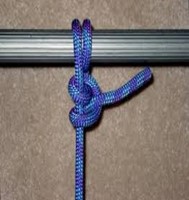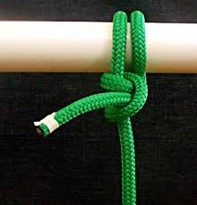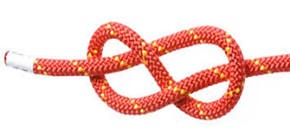‘NO, NOT THAT WAY, THIS WAY’: JUNIOR SKIPPER KNOTS (2 OF 2). EPISODE 3
By David Fraser
CSC Cruising Skipper and Instructor
Back again despite lack of popular demand, for Episode 3 in the Knots Saga. Those paying close attention (both of you) will note that this episode comes three weeks after the second. My editor (j/k) may have led you to believe these episodes would emerge every two weeks. Hahahahahaha. It’s sailing season! So for now: every three weeks. Or more.
If you are upset or aggrieved by this change, you may apply for a refund equivalent to what you initially paid. Send requests, along with documentation and a $50 bill to cover service charges, to:
D. Fraser
Basement Apartment Under the Stairs
Trump Tower
725 5th Ave, New York, NY 10022
My accountant will get back to you as soon as he’s released from Riker’s Island Correctional Facility in New York. Should you plan to visit and ask him to expedite your refund, here’s an actual Yelp review, no kidding.
https://www.yelp.com/biz/rikers-island-correctional-facility-east-elmhurst
Now, on to knotty matters.
QUOTE OF THE FORTNIGHT THREE WEEKS:
To cut the Gordian knot is not the same as to untie it. Children and lunatics cut what the poet patiently spends his life in trying to untie. ~Jean Cocteau
Required knots for Junior Skipper, Part 2
Under Cal Sailing Club’s Junior Skipper requirements, at
https://www.cal-sailing.org/images/official_files/Dinghy17.pdf , are nine knots. We looked at the Sheet Bend and the Bowline in Episode 2. Let’s review the rest. Remember: this series is not How To but more like What About. The pix and video links will give you the tying details.
CLOVE HITCH
https://www.animatedknots.com/clove-hitch-knot-rope-end
https://youtu.be/Gs9WyrzNjJs?feature=shared
This short, without hideous background music, shows two good ways to tie it.
I googled Clove Hitch and this popped up:

Ceci absolument n’est pas un clove hitch. It’s just not. You tell me what it is, if you dare.
This is :

Now, clove hitch tyer (or tier), (Merriam-Webster says it means “one that ties,”) beware:
“It does have two giant faults: it slips and, paradoxically, can also bind. It should be deeply distrusted when used by itself…..It is not a knot to be used alone.”
www.animatedknots.com [The online knots bible, cited above. The real knots bible is of course the

https://www.amazon.com/Ashley-Book-Knots-Clifford-W/dp/0385040253 which is worth having if you are a fellow Knots Knut. $53 on Amazon, which is a good deal. [I am not affiliated in any way, no ma’am, no sir.]
The clove hitch is good for briefly tying something to a spar or post. It is often used for tying fenders onto boat lifelines or other anchor points. It holds a tiller in place at the end of a voyage, strung between two cleats or winches. [I just make it with two overhand loops, putting the right hand loop behind the left, then onto the tiller.]
The clove hitch works best [meaning it shouldn’t slip] when there’s equal and opposite tension on the tails (working ends). There are plenty of more secure options, to be discussed in future episodes, and right here:
ROUND TURN AND 2 (OR 3) HALF HITCHES
https://youtu.be/M_W3nlil1Ko?feature=shared
This is a very nice demo that doesn’t drag on forever.
In blue here.

If you prefer green knots.

Note that ‘round turn’ does NOT mean once around the pole. Go twice. Or more, for security.
CSC teaches it with 3 half hitches for tying up at dock, which is more secure, and will just take another second. See if you can catch fellow members cheating ….
CLEAT HITCH
https://youtu.be/Gdu1xuJpJEw?feature=shared
Along with the Round Turn & Two Half Hitches [RT&2HH; some call it the 2 and 2], the Cleat Hitch is the most important of Episode 3’s knots.
Here’s a more detailed video with three methods, variants of each other.
https://youtu.be/Y8lokWSPwtA?feature=shared
Key tips:
- Always bring your line to the furthest horn of the cleat to start.
- If it’s windy, probably best to go around the base twice, or at least a full turn.
- Focus on getting the final move right. You should finish with two parallel lines under a single line. Do this until it’s automatic.
- Learn to do this vertically too. And from boat to dock. Your skippers will love you!
- The concentric circles that finish the excess line are called a Flemish coil, because it supposedly originated in Flanders (northern Belgium), where they speak _______ (fill in blank).
- It’s not called Flemland, despite some ignorant videographers.
- A lot of sailors reject the Flemish coil on the dock and say it’s better for the line to be loosely coiled and hung, versus getting stepped on.
- An exception is artist and Cruising Skipper Peter Baczek’s beautiful photo in the clubhouse. http://www.baczekstudio.com/baczekstudio/Baczek_Studio.html
STOPPER KNOTS / THE FIGURE 8
https://youtu.be/bZTmvpBmfYU?feature=shared
https://youtu.be/EtzeIQjcKEs?feature=shared
Tied by M.C. Escher

Tied by everyone else

The Figure 8 is a wonderful knot, and is the starting point for many useful variations. We’ll look at these in a future episode. Use it as a stopper near (not at) the end of your sheets. Make sure it stops at the fairlead so it won’t pull through and flog your crew. Unless they’ve been very very naughty.
Leave a decent tail behind the knot so it doesn’t flog itself free in a big wind, or tie a safety overhand knot next to it.
..... and then there’s this fun method. Haven’t tried it yet.
https://youtube.com/shorts/9rG1FtP05qQ?feature=shared
REEF KNOT (square knot)
Here, I’m just going to copy details from Episode 1. You can visit my knots blog on the CSC home page under Resources > Other Useful Info. If that’s too much work, you can click here: https://www.cal-sailing.org/csc-knot-corner/708-how-to-tie-two-lines-together
If you like, you can also sign up on CSC Slack for more discussions by the Illumiknoti (Matteson Daniel’s great term) about the blog. If it’s not listed in the Channels, just search for “knotsdiscussion.”
While – in case you hadn’t noticed – I’m still not a fan of the square knot/reef knot, during the discussions of Episode 1 several people pointed out a square knot around the mast is a good way to tie the mainsail tack into place. Be sure to reinforce it with overhand knots!
THE MOSTLY AWFUL SQUARE KNOT
https://www.animatedknots.com/square-knot
1A Few things are more satisfying than watching a landlubber tie two lines [which they call ‘ropes’] together. In the unlikely event that they know a knot or two, they will likely head for the door marked “Square Knot.” As with this guy:
https://youtu.be/OxdUfYKrcfY?feature=shared It’s better if sped up to 2x. Or 100x.

Clifford Ashley, author of Ashley’s Book of Knots, notes (ABOK p. 258):
“There have probably been more lives lost as a result of using a Square Knot as a bend (to tie two ropes together) than from the failure of any other half dozen knots combined.” Never use it for critical loads.
Check out 1:35 to 1:50 for a Scout True Horror Story:
https://youtu.be/PmZKG1bnXtE?feature=shared
The knot tying master Des Pawson [tell me he doesn’t look the part] says: It is still the best knot to tie together the end of a bandage or sling because it lies square or flat.

One of his many excellent books:
httpw.google.com/books/edition/Knots/rXoBEAAAQBAJ?hl=en&gbpv=1&printsec=frontcovers://ww
So: it works for a gift box, shoelace, bandage, even a tourniquet. For sailors, it is also known as the Reef Knot. That’s because you use it to tie reefing lines together, after, uh, reefing. Get used to tying it upside down on the boom. The knot, not you.
But never ever use it to tie two critical lines together. It won’t hold, and your boat, or spaceship, will just float away, leaving you looking for the Dayleader.
SLIP KNOT
This is the rock ‘n roll version.
https://youtu.be/A-GIsVcX62M?feature=shared
Many viewers agree to do this right you just need a bassist, rhythm guitar, keyboards, and a drummer.
Here’s the most annoying yet accurate YouTube version:
https://youtu.be/n3Xa7wh81Wo?feature=shared
Slip knots are very useful, usually as the start of another knot (lasso, trucker’s hitch, snap bowline). For the latter, which we’ll get to in an upcoming episode, be sure to pull the standing part through the overhand knot. Not the end that’s making the big loop.
SUPER BONUS SLIPKNOT:
https://youtu.be/l7oXx4Ob5og?feature=shared
BEAD KNOT
https://www.cal-sailing.org/images/official_files/Dinghy17.pdf
Just quoting from the CSC dinghy sailing manual (anyone know other uses?):
This knot is an alternate way to attach the halyard to the head of a sail (Fig 11: Securing Halyard To Mainsail With Bead Knot). It can also be used to secure the free end of the halyard to the standing rigging when the halyard is not in use. To tie the knot, make a loop near the free end of the halyard (Fig 11A). Push the end of the loop through the cringle in the head of the sail (Fig 11B). Catch the bead in the loop (Fig 11C), and pull the loop tight (Fig 11D).
See you next time, David
6.7.24

